
Tobruk

 |
Tobruk |
 |
The Characteristic of Tobruk defence in 1941.
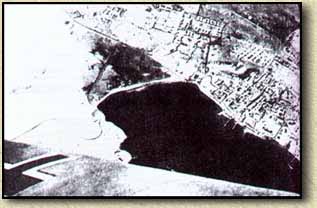
The view from air on fortress of Tobruk in 1941 .
The siege of Tobruk by German -Italian army started on 11-th Aprill 1941. Firstly only the 9 Australian 9-th Infantry Division in command of gen. Leslie Morshead and Australian 18-th Rifleman Brigade, a few British artilery regiments and uncompleted brigade of 32 tanks. There were 36 000 people inside the fortress who had 120 tanks, 76 guns and six regiments of artilery both light anf anti-tank. The fortress was built after the World War I by the Italians . The basic line of defence so called "red line" was shaped half circular which ends reched the coast of the sea. It was situated along the rocky mountains arround Tobruk from east to west. The best observation point was on the top of the hill Ras-el-Medauar (so called Hill 209) as high as 209 m above the sea level. The length of "red line" was 50 km and its radius aproximately 12-15 km . There was a barber wire barier along it , which surrounded machine-guns nests. There were 5 to 9 independent nests s along the first line , which were also situated in concrete or rocky shelters. The second circle of defense called "blue line" was situated 3-4 km away from the "red line" . There were four forts inside :Parrone, Arienti, Solaro, Pilastrino. The area was rather flat without any hils . The second line was built the same way folowing the firts ones scheme although the nests were ground-made and situated one by one. From the 1-st Aprill the main line of defence was divided into three parts : west, south and east. Each of them was defated by an infantry brigade. The west part which the most difficult especially after losing the hill of Medauar (after it this part od defence line was called "the gap") , was defeated by 26-th Infantry Brigade , the south one by 20-th Infantry Brigade and the south by 24-th Infantry Brigade. The fortress of Tobruk involved almost half of Italian -German army situated in Cirenaica . The first in command was the Italian marshal Ettore Bastico who was only teoretical commander . In fact the real commander was general Erwin Rommel (later promoted to feldmarshal) who often called his Italian colleague - "Bombastico".
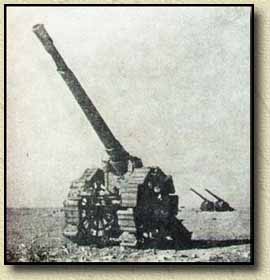
Those the haviest Italian guns (called by British "Bardia Bill") which attacked convoys and the harbour of Tobruk .

British Mk.2 Matilda tanks.
Italian Bersaliers.
The fortress was besieged by 21-st Italian Corps as well as two German regiments. Heavy artilery was situated in defile near El-Adem and behind the hill Ras-el Medauar . The German guns were situated as far as 8 km east of Tobruk which made them able to attack either the fortress or the harbour. Airforce was situated at the airports of El-Adem , Gambut ,Acroma, Martuba, Tmimi and Ghazala- about 12 km away from the first line of defence. The firts attacks of Tobruk took place in Aprill 1941 but all of them were repulsed. Unfortunatelly on 30-th Aprill German regiments managed to capture the Hill of Ras-el-Medauar (after it this part of defence line was called "the gap"). General Rommel finally decided to start regular besiege in May 1941. Because of the air-attacks water delivery as well as food , amunition was only possible during the nigths. The insects and lack of nutritious diet were also demanding. However the German propaganda gave the besiegders the mocking name of "Rats of Tobruk" but Polish,Australian and British soldiers accepted that name as a honourable one. They claimed thad they hadn't been captured by the "Fox of the Desert " - General Rommel. Most of the Polish werent very fond of their English colleagues but they liked the Australian very much. The brotherhood of soldiers became as strong as the Autralian (when they returned to their homes) have sent them the parcels with beer and invitation of setlement in Australia later on (after the war).
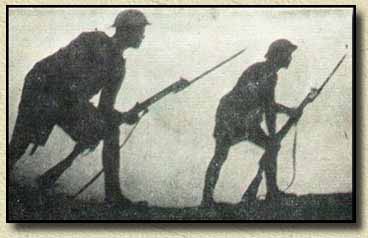
Nigthtwatch on the desert nearby Tobruk.
The participation of Carpathian Brigade at defence of Tobruk.
After the two-months defence of Tobruk Australian goverment claimed the withdrawfal of their army. Thus , at the end of July and the begining of August the decision was taken. Gen. Auchinleck repleced gen, Wavell in command of British Army in the Near and Middle East. British 70--th Infantry Division and Polish Carpathian Brigade (SBSK) were recommended to replace the Australians in Tobruk. On 15-th August gen. Kopański was called to Cairo and informed about the decision taken but the information was kept in secret in order to prevent any kind of German spies activity. Although the sea convoy was in danger of enemy attack at any time , the Carpathian Brigade was transported in 7 convoys (in the period of 18-25 August 1941) from Alexandria to Tobruk without any losts. At the time mentioned the Brigade consisted of 288 officers and 4777 soldiers. The first Polish unit which was sent do the defence was The Regiment of Carpathian Lancers. The unit consisted of 30 officers and 468 soldiers. On 29-th August they replaced Hindu 18-th Regiment of Cavaliery the right , seaside part of defence. They were ordered to defeat the part from a little bay Mersa-es-Sahel along the Wadi-es-Sahel defile which was four kilometers long. Some of their positions were situated in cencrete or rocky shelters which had been built by the Italians years before but on the other hand there were also some shelters made of stones. Władysław Bobiński was in command the regiment. The rest of Carpathian Brigade was sent on the second ("blue" ) line , replacing the 18-th Australian Brigade in region of Solaro fort. After a few days of stay the infantry battalions started replacing the Australians on the first line of defence. On 21-st August the Carpathian Artilety Regiment in command of col. Stanisław Gliwicz replaced the 51-st British Artilery Regiment and also received the order to support the 23-rd Australian Brigade. Infantry battalions having their own light -guns handed over the heavy equipment from the Australians. Each of battalions had on his position 80 heavy and light machine guns , 20 anti tank guns and 15 mortars. Polish Infantry units which were situated on the firt line in the region of El-Adem had the Australian neighbours from the east 24-th and 26-th Brigade . They all had 1-st and 107-th Regiment of British artilery to support. The part of line defended by Carpathian Brigade was 20 km long and its headquaters were situated inside the east bank of Pilastrino fort.
The part of defence line of 2 Battalion .
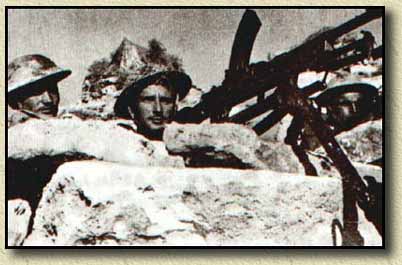
Polish Light machine gun in the defence nest in Tobruk.

Machine gun nest opposite Medauar Hill.
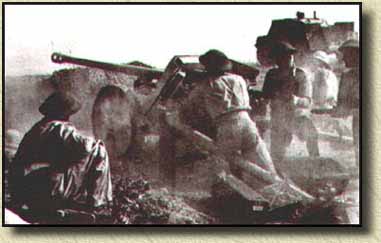
Polish artilery point opposite Medauar Hill.
Polish infantry stood opposite the 17-th Italian Armoured Division "Pavia" which had many more people and much more equipment . Despite the fact the Polish were still attacking them successfully in so called "patrols". During the whole month the Polish bothering them , taking prisoners, destroying communications lines and so on. For example Adolf Bocheński an intelelectualist , writer and a couragerous soldier was in command in many of those legendary patrols. In September 1941 he and his colleagues from 2 Battalion took part in 50 sallys . The most dangerous for all soldiers were mines which were layed on the desert by Italians , Germans, and also Australian, Polish and British. From 29-th September to 3-rd October the Brigade was sent to the most dangerous part of defence - so called "the gap" - replacing 26-th Australian Brigade . After it Polish infantry , cavaliery, and artilery took the position together. Since the Carpathian Brigade protected the part from coast in the west , accross the road to Derna including the Medauar Hill ("the gap") . Their defending points were situated about 200 m from the enemy positions. The soldiers weren't able to move because the pits were too shallow. There were able to receive the supplies of water and food only at night. The labor of fighting was enlarged by difficult climate conditions , hot sandy storms called "hamsin", the lack of water and only conserved very salty food . The long stay in these conditions on the desert and rocky hills was very exhausting for all soldiers who felt themselves abandoned there. During the daylight time the artilery of both sides worked all the time as well as German air force which was bombing the fortress and the harbour. The heaviest air raid was held on the second anniversary of German attack on Poland. At the same time inside the fortress the British 70-th Infantry Division in command of gen. Ronald Scobie came to the end of replacing the Australians. Three of Polish Battalions which were defending the part of line as long as 20 km were supported . Gen. Kopański received two additional Battalions - Australian 2-nd Battalion (commander col. Fredrick Burrows) and Chechoslovakian 11-th Battalion (commander col. Karel Klapalek). Because of the the convoy loses on 25-th October the additional see transports were cancelled. The Polish defended the most difficult part of Tobruk fortress in the region of Medauar Hill ("the gap" ) during 10 weeks . The previous record belonged to the Australians and took 4 weeks time.

The positions of armies inside the fortress of Tobruk after the taking the most dangerous sector in the region of Medauar Hill (so called "the gap" - "wyłom") by Polish Carpathian Brigade (SBSK).
The Polish broke this record of staying on "the gap" but not without loses. Only in October (1941) 20 soldiers died of mines , artilery attacks and taking part in patrols. In November 17 more lost their lives. But the Polish were also succesfull . On 13-th October one of the patrols captured three prisioners. On 6-th November Polish soldiers attacked the Medauar Hill supported by Polish and British artilery. On 8-th November the eight people unit in command of 2-nd lieutenant Witkowski from Regiment of Carpathian Lancers beat the Italians who had set up a trap . Eight Italian soldiers were killed and one of them was imprisioned. At night 10-11-th November the Polish patrol in command of 2-nd lieutenant Zgoła attacked the enemies in their machine-gun nest and captured their commander with four other soldiers. Those succesful attempts were very importrant because both sides prepared new offensive attack and any kind of information gained from prosioners about the enemy and his preparations was priceless.

12-th November 1941 gen. Władysław Sikorski the commander-in-chief PSZ visited the soldiers of Carpathian Brigade in Tobruk.
The visit of gen. Władysław Sikorski the commander-in-chief of PSZ in Tobruk was a great event for the soldiers of Carpathian Brigade (SBSK). He arrived on board of British destroyer "Kipling" on 12-13-th November and stayed there 36 hours. On 14-th November early in the morning gen. Sikorski visited an observation post of 2-nd Battalion on the area of "the gap" and field of cementary in Tobruk. Later he talked to the soldiers , some of them were promoted the others decorated . His stay was very immpresing as he was the only one of aliant commander (from such a high level) who had decided to visit a fortress situated as far inside the enemies line. In spite of the decision of an offensive attack more and more patrols and local fightings took place. On 18-th November 1941 British 8-th Army and 13-th Corps assumed the attack on the enemy border posts and the 30-th Corps was sent towards Tobruk from the east side. During the three days of attacks the Corps resached the region of Sidi-Rezegh moving toward El-Duda. On 21-st November the main battle took place in order to set Tobruk fortress free.

12 December 1941 - Carpathian Brigade started on offensive activity towards Derna.

Polish "carriers" on the way from free Tobruk.
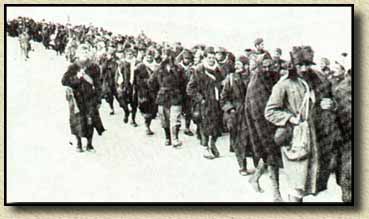
Tobruk set free - the enemy soldiers are marching to captivity.
Patrol of Polish (SBSK) "carriers".
At night 20- 21-st November Carpathian Brigade assumed an attack along the road to Derna and at the same time their artilery attack was set on the Medauar Hill in order to mislead the enemy. The main attack was held by 70-th British Division and 30-th Corpsin the south sector . The three -day bloody batle took place on the foreground of Tobruk. Gen. Rommel engaged his whole tank forces preventing the concetration of aliants . Despite of German activity the break out in the region of Sidi-Rezegh was saved. However on 25-th November the division from Newzeland 13-th Corps succeded in joing the aliant forces from Tobruk , but soon Rommel's tanks defeated them entirely. The next day Germans assumed an attack on Polish sector but there were beaten after heavy figting. The breaking down of British offensive didn't break the soldiers of Tobruk, who were fighting all the time long. Finally on 7-9-th December 1941 the Rommel's forces started their withdrawfall.At the night on 9-10-th December Carpathian Brigade attacked the Medauar Hill and next captured Acroma which brought them great deal of equipment and captives. After of three-week heavy fights the fortress was finally free. The defence of Tobruk took almost eight months. The Polish had defeated their sectors in fortress for almost four months (110 days) suffering loss of 109 killed , about 400 injured and several hundred ill soldiers. The Polish kept their positions till the end , survived in the most difficult sector ("the gap") , finally conquered Medauar Hill and Acroma. In 1941 in such a critical moment of war the long heroic defeat of Tobruk by aliants become a symbol of stubborn fight and survival till the complete victory.

10-th December 1941 - on the top of Medauar Hill which was conquered by Polish.
Transporter "Universal Carrier" from Carpathian Brigade.
El-Ghazala i Bardia.
The soldiers of Carpathian Brigade expected to be allowed to take rest at last. On 10-th December 1941 an British order to give back the best vehicles was received. But on 11-th December the other instructions arrived from the headquaters of British 70-th Infantry Division. It was said that the Brigade was supposed to be included to 13-th Corps so it should have been equiped by means of transport. On 12-th December the Polish still didn't have enough vehicles to leave Tobruk , Some of the vehicles so called "Tobruk taxies" were mostly damaged and devastated. But on 13-th December the Carpathian Brigade managed to reach El-Ghazala where was stopped on the area of Italian defensive line. On the next day gen. Godwin-Austeen - commander of 13-th Corps - ordered ordered Polish to captured Italians hinterland in order to stop their withdrawfal along the road Tobruk-Derna. The gap in enemy defensive line was supposed to be done by British . Unfortunately the British werent't able to break out so gen. Kopański decided to do it by themselves. After the reorganization required the Polish assumed the attack on 15-th December 1941. Am artilery support was expected from Carpathian Artilery Regiment and a battery of Newzelanders. However the Italians defeated strongly , the Polish managed to move them back and on the next day the Polish conquered the whole Ghazala position. On 17-th December the battle was over.
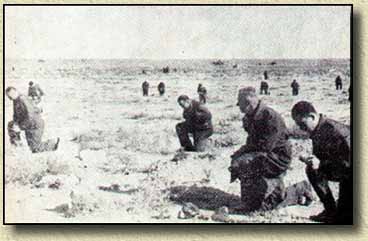
Before the battle of Ghazala - mass service - Polish soldiers are kneeling scaterated as the bullets may strike at any time.
The Polish captured 59 officers and 1634 soldiers as well as a great deal of eqipment : 10 heavy guns, 43 anti-tank guns, 3 anti-tank rifles, 87 heavy machine guns , 102 machine guns 38 motors and 12 vehicles. The whole Italian Battalion of Bersagliers including its commander surrendered. The Polish lost 25 killed, 94 injured and 6 disappeared. The Ghazala was very importrant from operative point of view for whole British 8-th Army in "Crusader" operation. The attack of the Polish Brigade broke out the strongest point of defence and forced the enemy to move back to the border of Tripolitania. Gen. Godwin-Austeen appreciated the Polish activity very well.
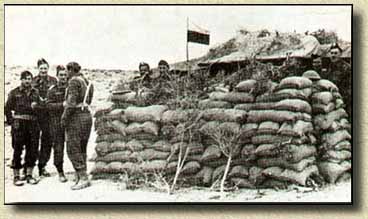
Ghazala - the place of Polish headquaters.
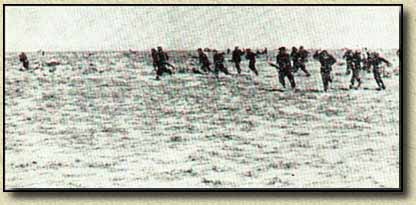
15-December 1941 - an attack of Ghazala.
El-Ghazala - December 1941 .
1bp, 2bp, 3bp - Polish Infantry Battalions , NZ - Newzelanders Battalions.
On 18-th December 1941 Carpathian Brigade was withdrawn to reserve of the 13-th Corps and sent to Ghazala Bay where they had been protecting the air force airport till 8-th January 1942. The Polish soldiers killed in Ghazala were burried on the cementary in Tobruk. On 25-th December 1941 Christmas Day gen. Kopański was ordered to sent Carpathian Artilery Regiment to Bardia. After the arrival the Polish suported South-African 2-nd Infantry Division which was attacking the Bardia fortress. German and Italian units were besieged there as the result of "Crusader " operation . Polish regiment owned 32 guns. The attack was started on 31-st December and was finished on 2-nd January 1942. During that time the Polish supported the 3-rd Infantry Brigade . The artilery fired their guns for 45 minutes before the attack and then the infantry started the first phase of capturing fortress which was succesfull. The next attack which took place 1-2-nd January was supported by Polish artilery again. At last the infantry broke out the enemy defeat and conguered the Bardia fortress. 7700 of Italians and 300 Germans surrended. The British lost 139 killed and 300 ijured. Carpathian Artilery Regiment lost two killed and 7 injured. At the same time gen. Kopański was called to the headquaters of British 8-th Army im Tmimi. Gen. Ritchie informed him about the new task which was protecting the northern part of Cirenaica from eventual airdrops or naval-landings as well as enemy attacks from the desert.
Designed by: © P.Jaroszczak - Przemyśl 1999.